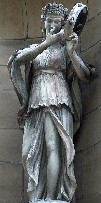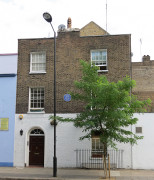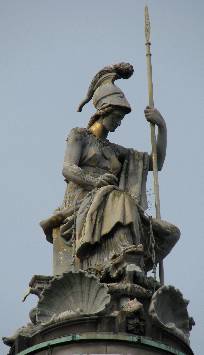John Charles Felix Rossi (1762-1839)
Dance, for Leicester.
The sculptor J. C. F. Rossi was born in Nottingham, his father being an Italian doctor. He studied sculpture under Locatelli, worked at the Derby China works, briefly for Vulliamy, then for the Coade manufactury. In 1781 he became a student at the Royal Academy Schools, exhibiting there for the first time in the following year, and on winning a travelling scholarship, spent three years in Rome. After his return to London, he formed a partnership with a mason-sculptor called J. Bingley, and drawing on his early training in terra cotta, made a variety of terra cotta and stone statues (much later he worked on terra cotta with J. H. Bubb). He flourished in the 1790s, winning commissions for architectural sculpture on important buildings, and designing four monuments in St Paul's. He was elected ARA in 1798, and RA in 1802. Over the course of a long working career, he managed to produce 16 offspring, by two wives, and of these three at least became sculptors - Henry Rossi in London, Frederick Rossi, and Charles Rossi, who became a monumental mason and went to live in Barbados. Rossi himself stayed in London, lodging for a period with the well-known painter Benjamin Hayden, in a modest house off Lisson Grove in Marylebone.
Rossi's home in Marylebone.
Rossi s typical style in his monuments and elsewhere, is draped or semi-draped classical figures, slender and refined looking with elegant long necks, somewhat recalling society pictures by Sir Thomas Lawrence. The faces are often rounded in a way which dates them firmly in the early rather than the later 19th Century, and there is a tendancy, as with 18th Century pictures, to have a female figure looking heavenwards. Otherwise, his female figures are moderately full in figure, rounded in the breast, slender in the arm and with long, expressive hands. There is a nice pair in this vein on the front of the Royal Opera House, London, depicting Thalia and Melpomene - these I believe to be to the design of Flaxman - and the Melpomene has his signature on the base - but it seems that Rossi was involved in the actual carving. Another pair are in Leicester - Music and Dance on the front of the City Rooms, and these are signed by Rossi and Bingley, though I understand that Rossi was the primary artist for these works. His St Paul's monuments are Cornwallis, Faulkner, Moss and Riou, and Rodney, all active in the war against Napoleon. His work also includes reproductions of classical works, including the four caryatids for St Pancras Church on Marylebone Road (see the top of the Caryatids page for picture).
Summit Britannia for Liverpool.


